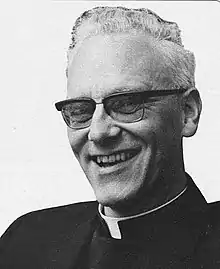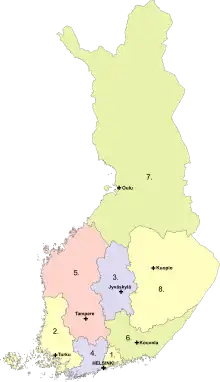Catholic Church in Finland
The Catholic Church in Finland (Finnish: Katolinen kirkko Suomessa) is part of the worldwide Catholic Church, under the spiritual leadership of the Pope in Rome.
| Part of a series on the |
| Catholic Church by country |
|---|
.svg.png.webp) |
|
|

As of 2018, there were more than 15,000 registered Catholics in Finland out of a total population of 5.5 million. There were also an estimated 10,000 unregistered Catholics in the country. Of the more than 6000 Catholic families in the country, half were Finnish and the rest from the international community.[1] Due to the small number of Catholics in Finland, the whole country forms a single diocese, the Catholic Diocese of Helsinki.
As of 2018, there were five native-born Finnish priests, three of whom work in Finland. There are more than 30 priests from different countries serving in Finland.[2] Since the 2019 retirement of Teemu Sippo, the first native-born Finnish Catholic bishop since the Lutheran Reformation, the Diocese of Helsinki has been vacant, i.e. without a bishop.
The Catholic Church in Finland is active in ecumenical matters and is a member of the Finnish Ecumenical Council, even though the worldwide Catholic Church is not a member of the World Council of Churches.[3]
History
Catholicism was the first form of Christianity introduced into the area of present-day Finland in the 12th century.[4] In the 16th century, Finland, as part of Sweden, took part in the Lutheran Reformation after which Catholicism lost almost all ground in the area.
The first Catholic religious service in Finland following the death of the Catholic King John III of Sweden in 1592 was celebrated in 1796 in Turku by the Apostolic Vicar of Sweden, the Italian-born Father Paolo Moretti.[5]
A parish was established in 1799 in Vyborg in the Russian part of Old Finland. After the rest of Finland became part of the Russian Empire in 1812, the parish covered the whole Grand Duchy of Finland. There were about 3000 Catholics in 1830. Until the 1860s, all the priests serving in Finland were Lithuanian Dominicans. The parish of Helsinki was founded in 1856, possibly due to the influence of the Governor General Friedrich Wilhelm von Berg's Italian wife, Leopoldina Cicogna Mozzoni (1786 – Warsaw 17 February 1874). St. Henry's Cathedral in Helsinki was finished in 1860.
In 1882 all the German priests and nuns were expelled. All foreign priests were expelled again in 1912. After Finland's independence and the departure of Russian military forces, which had included many Poles and Lithuanians, the Catholic Church lost most of its members.
In 1920 an apostolic vicariate was established in Finland. A parish in Turku was established in 1926, and in 1927 a parish in Terijoki. The Government granted the Catholic Church in Finland the status of religious community in 1929. Finland established diplomatic relations with the Holy See in 1942[6] and Pope Pius XII donated a significant sum of money to Finnish war orphans. After the war, the parishes in Vyborg and Terijoki, which had been located in territories that were ceded to the USSR, were moved to Lahti, and a new parish was founded in 1949 in Jyväskylä.
The Church of the Assumption of Mary was finished in Helsinki in 1954. The following year the apostolic vicariate was raised to a diocese. A parish in Tampere was established in 1957, a parish in Kouvola in 1985, and a parish in Oulu in 1992.
Catholic Church movements and groups are also active in Finland. One of these, the Neocatechumenal Way has established two Redemptoris Mater seminaries in Finland and maintains a presence both in Helsinki and in other towns, most notably Oulu.
A notable Catholic Finn in the early 21st century is the former head of the nationalist Finns Party, Timo Soini.
Bishops
Bishops of Turku
- Henrik, 1134–1158
- Rodolfus, 1202?–1209?
- Folkvinus, 1210?–1234?
- Tuomas, 1234?–1245
- Bero, 1248 tai 1249–1258
- Ragvald I, 1258–1266
- Catillus, 1266–1286
- Johannes, 1286–1290
- Maunu I, 1291–1308
- Ragvald II, 1309–1321
- Pentti Gregoriuksenpoika, 1321–1338
- Hemming, 1338–1366
- Henrik Hartmaninpoika, 1366–1367
- Johannes Pietarinpoika, 1367–1370
- Johannes Westfal, 1370–1385
- Bero Balk, 1385–1412
- Maunu Olavinpoika Tavast, 1412–1450
- Olavi Maununpoika, 1450–1460
- Konrad Bitz, 1460–1489
- Maunu III Särkilahti, 1489–1500
- Laurentius Michaelis, 1500–1506
- Johannes IV Olofsson, 1506–1510
- Arvid Kurck, 1510–1522
- Ericus Svenonius, 1523–1527
- Martti Skytte, 1528–1550
Bishops from 1923
Before the year 1955, Finland was a apostolic vicariate headed by an apostolic vicar, who was technically not the Bishop of Helsinki, but the titular bishop of a titular see, which is a defunct Roman Catholic diocese.
Apostolic Vicars of Finland 1923–1955
| Apostolic Vicars of Finland | Tenure | Additional Information | |
|---|---|---|---|
| Johannes Michiel Buckx | May 23, 1923 – July 26 1933 | Titular Bishop of Doliche | |
 |
Willem Petrus Bartholomaeus Cobben | December 19, 1933 – February 25, 1955 | Titular Bishop of Amathus in Palaestina. Appointed Bishop of Helsinki. |
Bishops of Helsinki 1955–
| Bishops of Helsinki | Tenure | Additional Information | |
|---|---|---|---|
 |
Willem Petrus Bartholomaeus Cobben | February 25, 1955 – June 29, 1967 | Resigned |
 |
Paul Verschuren | June 29, 1967 – September 18, 1998 | Resigned |
 |
Józef Wróbel | November 30, 2000 – June 28, 2008 | Appointed Auxiliary Bishop of Lublin |
| Teemu Sippo | June 16, 2009 – May 20, 2019 | First Finnish-born bishop in Finland since Arvid Kurck (1464–1522). Resigned. | |
Churches

There are eight Catholic parishes in Finland:
- St. Henry's Cathedral, Helsinki (Sub Centres – Tapanila (Vantaa), Porvoo)
- St. Brigit & Blessed Hemming Church, Turku (Sub Centres – Åland, Eurajoki, Pori)
- St. Olav's Church, Jyväskylä
- St. Mary's Church, Helsinki (Sub Centres – Olari (Espoo), Hyvinkää, Karis)
- Holy Cross Church, Tampere (Sub Centres – Hämeenlinna, Kokkola, Kristinestad, Jakobstad, Seinäjoki, Vaasa)
- St. Ursula's Church, Kouvola (Sub Centres – Hamina, Kotka, Lahti, Lappeenranta)
- Holy Family of Nazareth Church, Oulu (Sub Centres – Rovaniemi, Tornio, Kemi, Kajaani)
- St. Joseph's Church, Kuopio (Sub Centres – Mikkeli, Savonlinna, Joensuu, Lieksa)
Masses are also celebrated at the sub centres of the above parishes and some Lutheran and Orthodox Churches on alternative weeks. There is a Catholic Church retreat and education centre named Stella Maris in Lohja.[7]
There is a high demand for establishing a new parish in Northern Finland at Rovaniemi which is a major tourist destination in Lapland.[8]
Religious orders
The Bridgettine order is active in Finland with convents in Turku and Koisjärvi, near Lohja. A Carmelite convent, the Monastery of Our Lady of Mount Carmel in Finland was established in Espoo in 1988. The Dominican friars run a house in central Helsinki, home to a large library specializing in Christian studies and ecumenism named Studium Catholicum.[9][10]
The relics of Bishop Henrik
The ownership of the relics of Bishop Henrik caused some controversy between the National Board of Antiquities, the Catholic Church in Finland, and the Evangelical Lutheran Church of Finland. In 1998 the pastor of the Cathedral of Saint Henry in Helsinki wished to relocate Henrik's relics to the Cathedral, although they were previously exhibited in the Lutheran Cathedral of Turku.[11] The National Board of Antiquities eventually chose to place the relics in the Cathedral of Saint Henry in Helsinki.[12]
Liturgical languages
Because half of the Roman Catholics in Finland are members of the international community, the Catholic Mass is regularly celebrated in 20 other languages in addition to Finnish. The languages beyond Finnish in which the Mass is celebrated include Swedish, English, Polish, Vietnamese, Tagalog, Italian, Spanish, Portuguese, German, Malayalam, Tamil and Hungarian.
See also
References
- "Catholic church in Finland website (in Spanish language)".
- "Catholic church website (in Spanish language)".
- Finnish Ecumenical Council in English
- Finnish Cottage website, The History of Finland
- Catholic Turku website, Parish History
- "Suomi ja Vatikaani". Suomi ulkomailla (in Finnish). Retrieved 2 May 2023.
- Catholic 365 website, article dated July 27, 2015
- "Catholic church in Finland website (in Finnish language)".
- Katolinen website
- Stadium Catholicum website
- Heikkilä 2005, p. 94. Some historians have proposed that the translation took place already before 1296, or even so late than 1309. The year 1300 is from the mid-15th century Chronicon and remains generally accepted.
- Anton, Emil (2017). Katolisempi kuin luulit: Aikamatkoja Suomen historiaan. Helsinki: Kirjapaja. p. 14. ISBN 978-952-288-620-0.
Works cited
- Heikkilä, Tuomas (2005). Pyhän Henrikin Legenda. SKS. ISBN 951-746-738-9.
